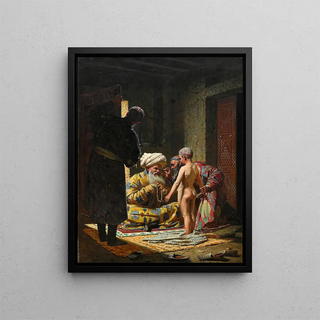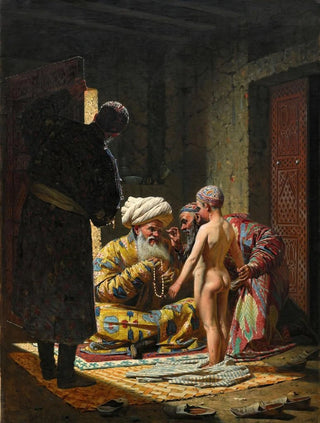Art print | The Sale of the Slave Child - Vasily Vereshchagin


View from behind

Frame (optional)
In the complex universe of art, some works transcend the simple frame of the canvas to become poignant witnesses of human history. "The Sale of the Slave Child" by Vasily Vereshchagin is one of these creations that provoke reflection and challenge us to consider the injustices of the world. This painting, imbued with dramatic intensity, immerses us in a scene where human suffering is brought to light, revealing the horrors of slavery. Vereshchagin, known for his commitment to social causes, uses his palette to evoke raw emotions, inviting us to contemplate tragedies that have marked history. Through this artwork, it is not just about representing a reality, but about fostering awareness that still resonates today.
Style and uniqueness of the work
Vereshchagin's style is characterized by striking realism, where every detail is carefully crafted to capture the essence of the subject. In "The Sale of the Slave Child," dark colors and accentuated shadows create a heavy atmosphere, while the expressions of the characters tell a story of despair and resignation. The artist does not seek to embellish the scene; on the contrary, he highlights the cruelty of the situation, making each face, each gesture, charged with palpable emotion. The composition is designed to guide the viewer's gaze toward the center of the action, where the child, at the heart of this tragedy, becomes both a symbol of vulnerability and a silent cry against injustice. Vereshchagin also employs perspective techniques to reinforce the feeling of oppression, inviting the viewer to immerse themselves in this disturbing reality.
The artist and his influence
Vasily Vereshchagin, born in 1842, is an emblematic figure of Russian art, whose work is marked by a deep social and political commitment. His artistic journey is closely linked to his travels, notably in the Orient, where he witnessed the suffering of oppressed peoples. This experience nourished his art, leading him to address difficult themes such as war, poverty,

Matte finish

View from behind

Frame (optional)
In the complex universe of art, some works transcend the simple frame of the canvas to become poignant witnesses of human history. "The Sale of the Slave Child" by Vasily Vereshchagin is one of these creations that provoke reflection and challenge us to consider the injustices of the world. This painting, imbued with dramatic intensity, immerses us in a scene where human suffering is brought to light, revealing the horrors of slavery. Vereshchagin, known for his commitment to social causes, uses his palette to evoke raw emotions, inviting us to contemplate tragedies that have marked history. Through this artwork, it is not just about representing a reality, but about fostering awareness that still resonates today.
Style and uniqueness of the work
Vereshchagin's style is characterized by striking realism, where every detail is carefully crafted to capture the essence of the subject. In "The Sale of the Slave Child," dark colors and accentuated shadows create a heavy atmosphere, while the expressions of the characters tell a story of despair and resignation. The artist does not seek to embellish the scene; on the contrary, he highlights the cruelty of the situation, making each face, each gesture, charged with palpable emotion. The composition is designed to guide the viewer's gaze toward the center of the action, where the child, at the heart of this tragedy, becomes both a symbol of vulnerability and a silent cry against injustice. Vereshchagin also employs perspective techniques to reinforce the feeling of oppression, inviting the viewer to immerse themselves in this disturbing reality.
The artist and his influence
Vasily Vereshchagin, born in 1842, is an emblematic figure of Russian art, whose work is marked by a deep social and political commitment. His artistic journey is closely linked to his travels, notably in the Orient, where he witnessed the suffering of oppressed peoples. This experience nourished his art, leading him to address difficult themes such as war, poverty,






